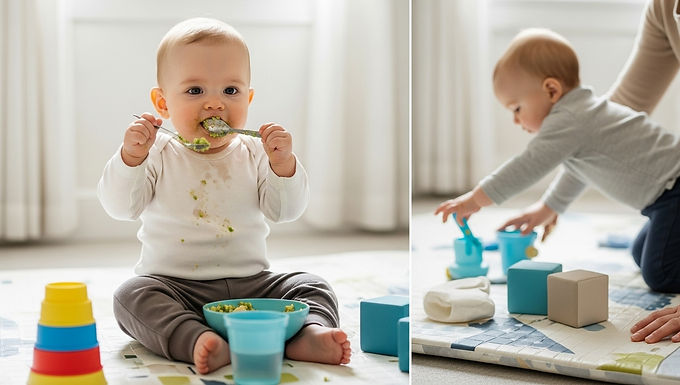
Your baby is now around 6 to 7 months old, entering a stage full of movement, curiosity, and new tastes. They’re becoming more independent in small but meaningful ways—sitting up more steadily, exploring toys with intent, and starting to enjoy more solids alongside milk.
This is a wonderful time for growth in every sense.
What’s Happening with Your Baby in Weeks 25–28?
Sitting with more stability. Some babies can sit unsupported for short periods.
Early crawling attempts. You might see rocking on all fours or even backward scooting.
Better hand coordination. Picking up toys and passing them between hands is now deliberate.
Raking grasp. They’ll start using their fingers to rake soft foods or small objects.
More vocal. Babbling may include repetitive sounds like “ba-ba” or “da-da” (though not real words yet).
Your baby is much more engaged with their environment and eager to explore.
Feeding: Solids + Milk
At this stage, solids become an important addition but not the main nutrition source. Breastmilk or formula is still essential.
You can:
Offer 1–2 solid meals per day, gradually increasing variety.
Try smooth purees, soft mashed foods, or safe baby-led weaning finger foods.
Introduce iron-rich foods like lentils, well-cooked meat, or fortified cereals.
Begin offering sips of water in a small cup during meals.
Continue to introduce one new food at a time, watching for any allergic reactions.
Expanding Flavors
Now is a great time to expose your baby to a variety of tastes:
Mild vegetables like zucchini, pumpkin, peas.
Soft fruits like banana, pear, peach.
Protein options like finely mashed beans, soft tofu, or flaky fish (avoid bones).
Avoid adding salt, sugar, or honey. Keep flavors simple and natural.
Poop with Solids
As solids increase, diapers will change more:
Texture becomes thicker, sometimes pasty.
Colors vary widely—orange from carrots, green from peas, etc.
The smell becomes stronger compared to milk-only poop.
Call your pediatrician if you see blood, white stools, or persistent constipation.
Movement and Mobility
Mobility is a big focus now.
More tummy time leads to crawling readiness.
Some babies start lunging forward or doing a “commando crawl.”
Sitting becomes stronger—falling over less often.
You can encourage movement by placing toys just out of reach or giving them safe space to roll and wiggle.
Sleep During This Stage
As babies become more active, sleep patterns may shift:
They might sleep more soundly after busy play sessions.
Some babies drop to 2 longer naps instead of several short ones.
Nighttime sleep can improve, but temporary disruptions happen with new skills like sitting or crawling.
A consistent bedtime routine helps them settle despite new excitement.
Playtime and Interaction
Playtime is richer and more interactive now.
Stacking cups or soft blocks for sensory play.
Toys that make gentle sounds when shaken or pressed.
Simple cause-and-effect games like dropping toys and watching you pick them up.
Singing action songs with hand motions—they’ll watch and try to imitate.
This stage is perfect for encouraging exploration while keeping a safe environment.
A Gentle Reminder
Weeks 25–28 are a beautiful mix of movement and discovery. Your baby is learning how their body works, exploring new foods, and becoming more independent every day.
Take your time with solids—there’s no rush to create a full meal plan. And remember, the mess is part of the process.
What’s Coming Next?
Weeks 29–32 will bring even more mobility—some babies will crawl confidently, while others may start pulling up to stand. We’ll also cover how to safely introduce allergenic foods like eggs and peanuts, and how to balance solids with continued milk feeds.


